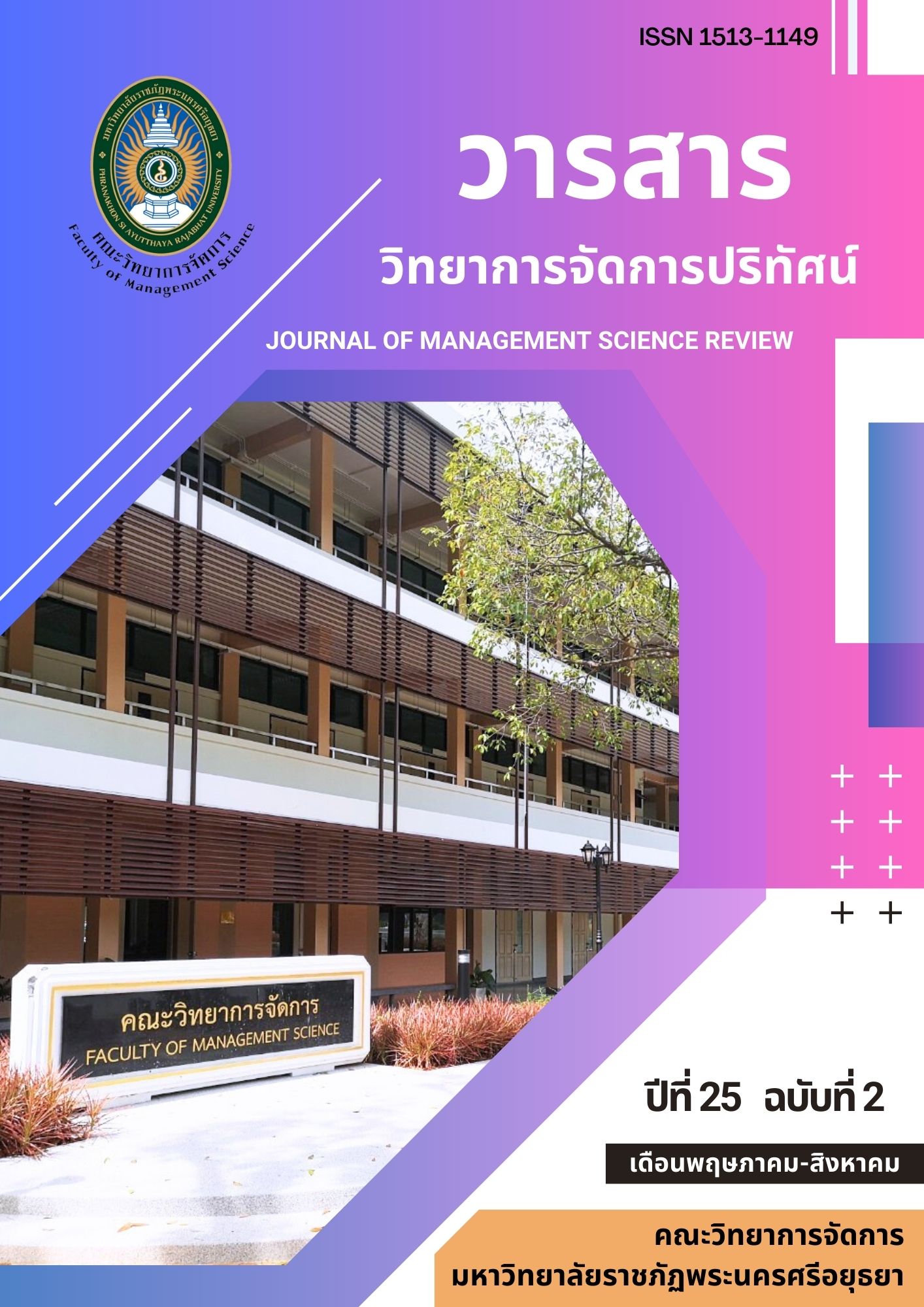Factors which Influence Thai consumers’ perception on benefits of Cannabis contained products
Keywords:
Perceived Benefits, Healthy Food, CannabisAbstract
The objectives of this research were: 1) to study cognitive factors in various dimensions; 2) to study the structural relationship between the factors of cannabis healthy food choices and perceived food benefits for Thai consumers in choosing healthy food from cannabis, and 3) to prioritize consumer perception factors affecting cannabis-based healthy food choices using an Importance-performance map analysis (IPMA). The subjects used in the study were 300 working-age consumers aged 20 and over living in Thailand who had consumed cannabis-based healthy foods since 2022. The study tool was an online questionnaire. Statistics used in data analysis were percentage, mean, and standard deviation. Structural Model Assessment and Partial Least Square Structural Equation Model: PLS-SEM were used to analyze and find relationships between variables using the SMART-PLS package.
The study found that most of the respondents were female, aged between 20-30 years old. Most of them had bachelor's degree education, worked as private employees, and earned more than 45,000 baht per month. From the results, it was found that 1) the respondents had positive opinions on social, emotional, value, and taste, respectively, and no positive opinions on safety on perceived benefits of food. 2) From the results of the structural equation analysis of consumer choice on the perceived benefits of cannabis healthy food, it was found that the social aspect had the second highest effect on the perceived benefits of cannabis healthy food. comes in terms of emotion, value, taste, and safety, respectively. 3) the priority of the factor of perceived benefit from the method IPMA results indicated that respondents value social aspects the most, followed by emotion, value, taste, and safety, respectively.
References
กนกพร มโนมัยพันธุ์. (2564). การศึกษาการรับรู้คุณค่าของผู้บริโภคของสายการบินไทยสมายล์แอร์เวย์ที่ส่งผลต่อการตัดสินใจเลือกใช้บริการสายการบินภายในประเทศ. สารนิพนธ์ปริญญาการจัดการมหาบัณฑิต, มหาวิทยาลัยมหิดล.
กรุงเทพธุรกิจ. (2558). ‘ทัศนคติ’ ความหมาย และความสำคัญ. จาก https://www.bangkokbiznews.com/blogs/columnist/109397.
คลังความรู้ (Scimath). (2562). กัญชากับการประโยชน์ในทางการแพทย์. จาก https://www.scimath.org/article-chemistry/item/9808-2019-02-21-07-38-06
ชนัญชิดา คำมินเศก. (2553). การรับรู้สื่อรณรงค์ Quit Line 1600 สายเลิกบุหรี่และความคิดเห็นของข้าราชการทหาร กองบัญชาการกองทัพไทย. วิทยานิพนธ์นิเทศศาสตรมหาบัณฑิต สาขาวิชานิเทศศาสตร์ธุรกิจ, มหาวิทยาลัยธุรกิจบัณฑิตย์.
ชนม์ชุดา วัฒนะธนากร และบุฏกา ปัณฑุรอัมพร. (2563). ปัจจัยที่มีผลต่อการตัดสินใจซื้อเครื่องดื่มที่มีส่วนผสมของกัญชา-กัญชงของผู้บริโภค. วิทยานิพนธ์บริหารธุรกิจมหาบัณฑิต สาขาวิชาบริหารธุรกิจ, มหาวิทยาลัยรามคำแหง.
นริศา คำแก่น และ เจริญ ตรีศักดิ์. (2562). กัญชาทางการแพทย์สำหรับมะเร็ง. The Journal of Chulabhorn Royal Academy, 1(1), 16-29.
พิณิชา กิจเกษมพงศา. (2561). คุณภาพของอาหาร ความคุ้มค่าด้านราคา ความพึงพอใจ คุณค่าด้านสุขภาพ และทัศนคติต่ออาหารที่มีอิทธิพลต่อการตัดสินใจซื้ออาหารริมทางของผู้บริโภคในกรุงเทพมหานคร. จาก http://dspace.bu.ac.th/bitstream/123456789/3796/1/pinicha_kitk.pdf.
พัลลภา ปิติสันต์ และ พัชณี มาเสถียร. (2564). การรับรู้คุณค่าด้านผลิตภัณฑ์และทัศนคติที่ส่งผลต่อการตัดสินใจซื้อผลิตภัณฑ์เครื่องดื่มเสริมอาหารที่ใช้สารให้ความหวานแทนน้ำตาลของผู้บริโภค. สารนิพนธ์ปริญญาการจัดการมหาบัณฑิต, มหาวิทยาลัยมหิดล.
พัชรี เชยจรรยา และคณะ. (2543). ทฤษฎีแม่บททางนิเทศศาสตร์. กรุงเทพฯ : จุฬาลงกรณ์มหาวิทยาลัย.
มนัสพงศ์ พัฒนวิบูลย์. (2553). การรับรู้ข่าวสาร และทัศนคติของประชาชนผู้รับบริการเกี่ยวกับภาพลักษณ์ในการให้บริการของธนาคารสินเอเซีย จำกัด (มหาชน). วิทยานิพนธ์นิเทศศาสตรมหาบัณฑิต สาขาวิชานิเทศศาสตร์ธุรกิจ, มหาวิทยาลัยธุรกิจบัณฑิตย์.
ยูนิลีเวอร์ ฟู้ด โซลูชั่นส์ (Unilever Food Solution). (2565). เทรนด์อาหารกำลังมาแรงปี 2022: อาหารเพื่อสุขภาพ. จาก https://www.unileverfoodsolutions.co.th/th/chef-inspiration/trendwatch/trend1-healthier-indulgence.html.
รัชกร อัครพิน. (2562). อิทธิพลของทัศนคติต่อการมีสุขภาพดีและทัศนคติต่อรสชาติที่มีผลต่อการเลือกบริโภคอาหารเพื่อสุขภาพ: พิจารณาในบทบาทของการรับรู้เชิงคุณค่าต่อสุขภาพ และการรับรู้ถึงความคุ้มค่า. สารนิพนธ์ปริญญาการจัดการมหาบัณฑิต, มหาวิทยาลัยมหิดล.
Fornell, C., & Larcker, D. F. (1981). Evaluating structural equation models with unobservable variables and measurement error. Journal of Marketing Research, 18(1), 39-50.
Henseler, J., Hubona, G. & Ray, P. A. (2016). Using PLS Path Modeling in New Technology Research: updated guidelines. Industrial Management & Data Systems, 116(1), 2–20
Hu, L. T., Bentler, P.M. (1999). Cutoff criteria for fit indexes in covariance structure analysid: Conventional criteria versus new alternatives. Structural Equation Modeling, 6, 1-55.
Slimani, N., Ferrari, P., Ocke, M., Welch, A., & Boeing-Messing, H. (2015). Standardization of the 24-hour diet recall calibration method used in the European prospective investigation into cancer and nutrition (EPIC). from http://hypatia.teiath.gr/xmlui/handle/11400/8709?show=full.
Venkatesh, V.,Morris, M. G.,Davis, G. B., & Davis, F. D. (2003). User acceptance oof information technology: Toward a unified view. MIS quarterly, 27(3), 425-478.




